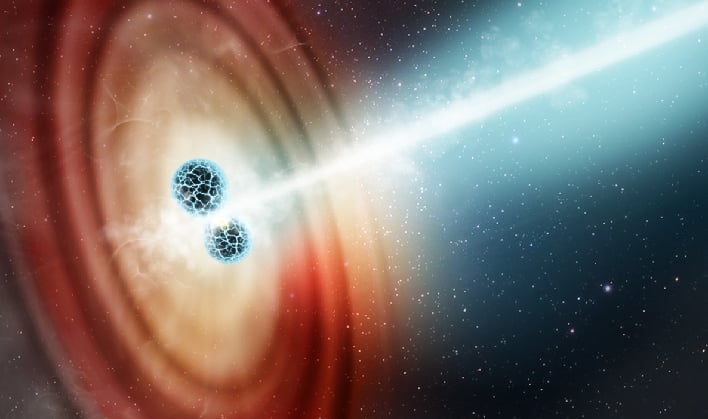NASA Telescope Reveals Jet Blast From Colliding Stars Traveling At Incredible Speed

A neutron star is the surviving core of massive stars that have exploded. These dense stars are said to weigh more than our very own Sun, and would fit inside New York City, according to NASA. A mere teaspoon of surface material from one of these would weigh in at a mammoth 4 billion tons here on Earth. So, astronomers were thrilled when they were able to capture the aftermath of two of these cannon balls of compacted material colliding.
The aftermath of the event, called GW170817, was seen by 70 observatories around the world and in space. Scientists reacted quickly, and aimed the Hubble telescope in the direction of the explosion two days later. After colliding, the two neutron stars "collapsed into a black hole whose powerful gravity began pulling material toward it." This led to the material forming a rapidly-spinning disk which produced jets moving outward from its poles. The jet then slammed into and swept up material in the growing shell of explosion debris, which included a "blob" of material through which a jet appeared.
While the event happened in 2017, it has taken scientists and researchers several years to make sense of the data that was collected by Hubble and other telescopes. Hubble's data was combined with observations from several National Science Foundation radio telescopes, which were captured 74 days and 230 days after the explosion.
"I'm amazed that Hubble could give us such a precise measurement, which rivals the precision achieved by powerful radio VLBI telescopes spread across the globe," stated Kunal P. Mooley of Caltech in Pasadena, California, and lead author of a paper being published in the October 13 journal of Nature magazine.
Jay Anderson of the Space Telescope Science Institute in Baltimore, Maryland, remarked, "It took months of careful analysis of the data to make this measurement."
Researchers were able to pinpoint the site of the explosion, by combining the different observations. Hubble's measurement indicated that the jet was moving at a speed of seven times the speed of light. Later, the radio observations showed the jet had slowed down to around four times the speed of light.

"Our result indicates that the jet was moving at least at 99.97% the speed of light when it was launched," explained Wenbin Lu of the University of California, Berkley.
NASA says that the work done while studying GW170817 will pave the way for more precision studies of neutron star mergers in the future. If enough data can be collected, "relativistic jet observations might provide another line of inquiry into measuring the universe's expansion rate, associated with a number known as the Hubble constant."

